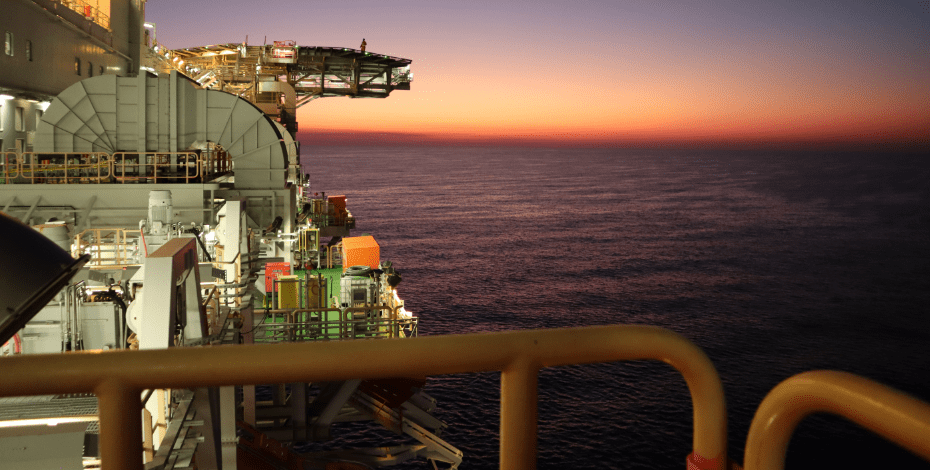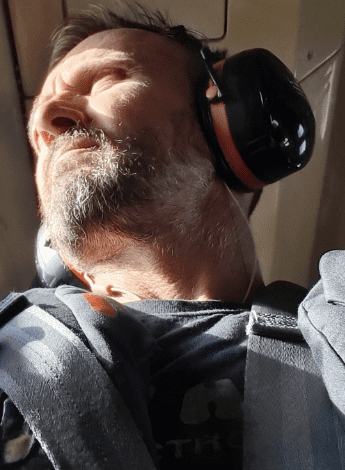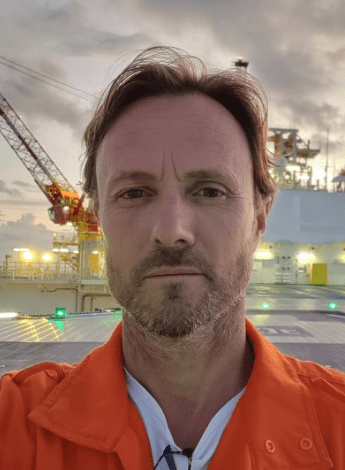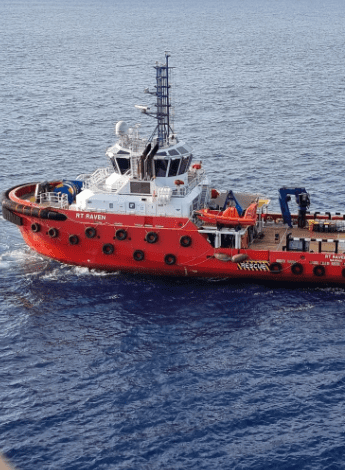
Healing on the high seas

As far as wildly different work environments go, offshore oil rigs would have to rank among the more unusual.
As Kieran Bell tells it, treating workers on an oil rig in the Timor Sea off Western Australia is an opportunity of a lifetime to build on his occupational health skills and expand his horizons.
Due to their inherently hazardous environments, safety is paramount when working on an oil rig.
In particular, offshore oil rigs are fraught with potential dangers including high-pressure systems, flammable materials, heavy machinery and unpredictable weather.
For every moment that he is on board the Japanese-operated INPEX oil and gas rig—located in the Timor Sea some 220 kilometres from the Western Australia coast—physiotherapist Kieran Bell APAM is acutely aware of the need to exercise caution and care.
‘Over time’, Kieran says, ‘the embedded culture of safety becomes instinctual’.
The semi-submersible oil and gas rig (known as the central processing facility) and the nearby floating production, storage and offloading unit (FPSO) shaped much like an oil tanker, are two work locations that Kieran has frequented six times in the past two years.
These sea giants loom large on the horizon when approached by air in the Sikorsky helicopter it takes to reach them.
It’s a two- hour flight that Kieran has completed many times, flying back and forth to the INPEX offshore facilities from the Broome heliport.

Kieran in the helicopter flight out to the oil rig.
‘I love approaching the helo and getting on board. The jet stream of warm air from the rotor downdraft is so strong it forces you to lean into it to make headway, the blades whooping a couple of feet above your head.
'The flight is noisy and the helo shakes and rattles, but it’s a blast; taking a helicopter across the ocean to a rig that is over the horizon makes for a cinematic experience,’ Kieran says.
‘You jump out of the chopper out onto the helideck and initially, it’s all foreign.
'You’re on a ship or in the case of central processing facility it’s a giant square, a semi-submersible platform.
'It has these big steel columns pulled down by anchors held under floatation pressure to stabilise it against the sea.’
In order to be permitted to set foot on the offshore facilities, Kieran first had to undertake rigorous helicopter underwater escape training, which involved two days in a swimming pool in the Perth suburb of Jandakot.
Using a submerged helicopter simulator, Kieran learned post-accident water survival techniques including life jacket and life raft training.
It is part of the gruelling safety training package that every offshore worker must do, which includes tropical-based offshore training, site-based inductions and passing a medical examination.
Prioritising safety on board these gigantic structures helps prevent accidents that can lead to serious injuries or fatalities.
INPEX’s culture of safety fosters a more efficient and productive workplace for the hundreds of employees, contractors and consultants who work in shifts on the central processing facility and FPSO.
Ensuring that the strict safety protocols are met is crucial to the entire operation, underpinning all facets of life on the oil rig.
They run hand-in-hand with a focus on the mental and physical wellbeing of everyone on board, which is where Kieran fits in.
‘The culture on board is guarded quite strongly and the leadership protect their morale out of necessity.

Kieran Bell on board the INPEX oil rig.
'When you’re isolated out at sea for that long, keeping up morale is paramount,’ Kieran says.
‘So they look after their people as best they can. They’ve done better than anywhere I’ve seen in any other industry.
'I think oil and gas is another level again of proficiency. The facilities are really tight and well-kept.
'Their management teams have been headhunted across their professions and they’re the best at what they do, from what I can see.
‘The offshore environment is unique. It demands a high-level presence from you, given that everything is so critical.
'Even the first time you get on the helideck, you could walk off it and fall 70 metres to the water level, never to be seen again.’
Kieran, who is the managing director of Mouat West Physiotherapy when he is ‘on the beach’ (mainland), delivers the Strong Spine program (see below) to the offshore oil rig workers through training sessions that fit around the workers’ shifts.
All manual labour workers on the oil rig—from boilermakers, scaffolders and engineers to electricians and painters—are also required to undertake some level of desk-bound paper and computer work.
Kieran’s role is to help workers understand what the manual handling risk is, how to move better and how to prepare their bodies for the variety of movement their particular job entails.
The goal is to help the workers establish habits to lower their personal risk of injury, with stretching being one of the tools employed to meet that aim.
When Kieran is on board the oil rig or FPSO he is there for an eight-day stint (‘I’m eight days away from home, which gives my wife and five kids a break from me!’).
During that time he eats, sleeps and moves about the oil rig or FPSO just as the workers do, having to abide by the same rules and practices in place for everyone.
Sometimes Kieran will be allocated a bunk bed to himself and other times he needs to ‘hotbed’, which involves one person sleeping in the room while another is on shift, with bed linen changed and the space cleaned between each night and day shift rotation.

An intake vessel makes its way to the gas and oil rig in the Timor Sea.
Soft-soled shoes must also be worn inside the accommodation block and once you leave your sleeping quarters in the morning, you are not able to return until bedtime, so as not to disturb anyone who might be sleeping.
Kieran admits that while you can sometimes hear people walking around while lying in your bunk bed, the noise of the plant in operation 24/7 is surprisingly minimal. What isn’t minimal is the food.
Kieran says the workers are served plentiful chef-made quality meals as well as having 24-hour access to fruit and snacks.
The likelihood of gaining a few kilos, even in eight days, is very real.
Kieran shares that everyone flown on and off the oil rig is weighed to ensure the helicopter is not carrying too much weight for the journey.
‘Maintaining a healthy weight requires a measure of self-discipline, particularly when pastry chefs are flown in,’ Kieran says.
While on board Kieran works 12- to 18-hour days to enable him to cater for workers on both day and night shifts.
Because the oil rig operates 24 hours a day, seven days a week, there is no single period of downtime for everyone on board.
All those inside the oil rig or FPSO work in an air-locked, temperature-controlled environment but outside temperatures can get very hot and humid.
This means that Kieran needs to adapt his 90-minute exercise training sessions to the particular setting.
The oil rig and FPSO both have state-of-the-art gym facilities where Kieran holds most of his training sessions; however, the helipad on the oil rig also doubles as a spectacular outdoor training area that offers 360-degree views of endless ocean.
Sometimes Kieran holds late afternoon sessions out here for the evening workers ahead of the start of their shift—if it’s not too hot.
With the backdrop of a beautiful sunset and indigo ocean, it has to be one of the more sublime locations to deliver an exercise program.
‘There are a lot of things that blow my mind in the time I’m out there that I imagine you get used to after being there a while.
'But, certainly, many of those things are still novel to me.’
Forging a strong alignment
Having donned a hardhat and safety gear to work as an occupational health physiotherapist at construction and mining sites in Western Australia, Kieran Bell had a fortuitous meeting with Kingsley Flett.
Kingsley, who has a master’s degree in human movement and who suffered his own workplace injury as a young man, had developed a teaching system that could be used in injury prevention and rehabilitation.
The program was designed to create lasting change in people’s habits, and is known as the Strong Spine System.
Sharing the same beliefs that Strong Spine’s approach was a powerful tool for those in manual labour professions, Kieran introduced the program within the company he had started, Biosymm Workplace Injury Management.
At that time Biosymm counted sodium cyanide and explosive grade ammonium nitrate producer CSBP Kwinana, Rio Tinto Iron Ore and BHP Nickle among its clients.
After a decade and a half Kieran found his heart was no longer in the approach that industry had come to expect from Biosymm and after selling his stake in Biosymm, he began to work exclusively with Kingsley in delivering the Strong Spine program to its target audience of oil rig workers, miners, farmers, drillers, customs officers, police force personnel, nurses, soldiers, grave-diggers, plumbers, mechanical fitters, electricians, carpenters, diesel fitters, chefs, fishermen and divers.
‘Kingsley has a background in coaching.
'What it was about Kingsley’s session that really appealed to me was that it was movement-based.
'As physiotherapists we’re taught in a fairly didactic kind of information-based manner, so you end up just delivering a lot of information to your clients.
'Strong Spine gives people an opportunity to learn through their experience.
'Much like the approach to therapy I have recently adopted with cognitive functional therapy.
‘Kingsley did a lot of work with Woodside in the 90s and many of the lads he got to know on the tools then are now in the leadership team at INPEX, Woodside and Shell.
'They’re still in the industry, so that’s how we got the gig with INPEX,’ Kieran says.
‘But we didn’t want to deliver any old program, not the “death by a thousand slides” PowerPoint presentation.
'We like to get straight into what’s going to matter to the workers, and that is where Strong Spine comes in as an extremely valuable teaching tool.
‘We are wholly concerned in triggering the intrinsic motivation in each trainee to change the way they move, what risks they perceive and how they manage themselves,’ Kieran says.
‘The program began its life in the power stations of Western Australia’s south-west in the late 1980s and since then has evolved by teaching hundreds of thousands of people how to understand what manual handling risk really is, how to move better and how to prepare their bodies for work.’
© Copyright 2025 by Australian Physiotherapy Association. All rights reserved.





